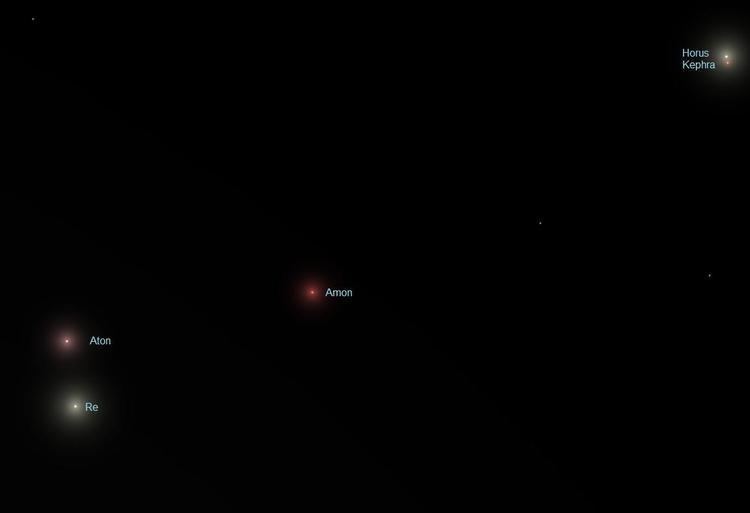Companion ξ UMa A U−B color index 0.04 Apparent magnitude (V) 3.79 (4.32/4.84) Parallax (π) 113.20 ± 4.60 mas | Semi-major axis (a) 2.536" B−V color index 0.59 Absolute magnitude (MV) 4.71/5.23 | |
 | ||
Proper motion (μ) RA: −429 mas/yr; Dec.: −587 mas/yr | ||
Xi Ursae Majoris (ξ Ursae Majoris, abbreviated Xi UMa, ξ UMa), also named Alula Australis, is a star system in the constellation of Ursa Major. On May 2, 1780, Sir William Herschel discovered that this was a binary star system, making it the first such system ever discovered. It was the first visual double star for which an orbit was calculated, when it was computed by Félix Savary in 1828.
Contents
Stellar system
The two components are yellow G-type main-sequence stars. The brighter component (designated Xi Ursae Majoris A), has a mean apparent magnitude of +4.41. It is classified as an RS Canum Venaticorum type variable star and its brightness varies by 0.01 magnitudes. The companion star (Xi Ursae Majoris B) has an apparent magnitude of +4.87. The orbital period of the two stars is 59.84 years, and they are currently separated by 1.2 arcseconds, or at least 10 AU.
Each component of this double star is itself a spectroscopic binary. B's binary companion (Xi Ursae Majoris Bb), is unresolved, but the binary star is known to have an orbital period of 3.98 days. The masses of both A and B's companions (Ab and Bb) (deduced by the sum total mass of the system minus the likely masses of Aa and Ba determined by their class) indicate that they are probably MV stars (red dwarfs), Bb being on the cool end of the M spectrum, not much hotter than a brown dwarf.
In 2012 Wright et al. discovered the fifth component and the second brown dwarf (if Bb is also a brown dwarf) of the system using Wide-field Infrared Survey Explorer (WISE) data—a T8.5 brown dwarf WISE J111838.70+312537.9 with angular separation 8.5 arc-min, and the projected physical separation about 4000 AU.
Nomenclature
ξ Ursae Majoris (Latinised to Xi Ursae Majoris) is the star's Bayer designation.
It also bore the traditional names Alula Australis (and erroneously Alula Australe). Alula (shared with Nu Ursae Majoris) comes from the Arabic phrase Al Ḳafzah al Ūla 'the First Spring' and Australis is Latin for 'the south side'. In 2016, the International Astronomical Union organized a Working Group on Star Names (WGSN) to catalog and standardize proper names for stars. The WGSN's first bulletin of July 2016 included a table of the first two batches of names approved by the WGSN; which included Alula Australis for this star.
In Chinese, 三台 (Sān Tái), meaning Three Steps, refers to an asterism consisting of Xi Ursae Majoris, Iota Ursae Majoris, Kappa Ursae Majoris, Lambda Ursae Majoris, Mu Ursae Majoris and Nu Ursae Majoris. Consequently, Xi Ursae Majoris itself is known as 三台六 (Sān Tái liù, English: the Sixth Star of Three Steps) and 下台二 (Xià Tái èr, English: Star of Second Lower Step).
